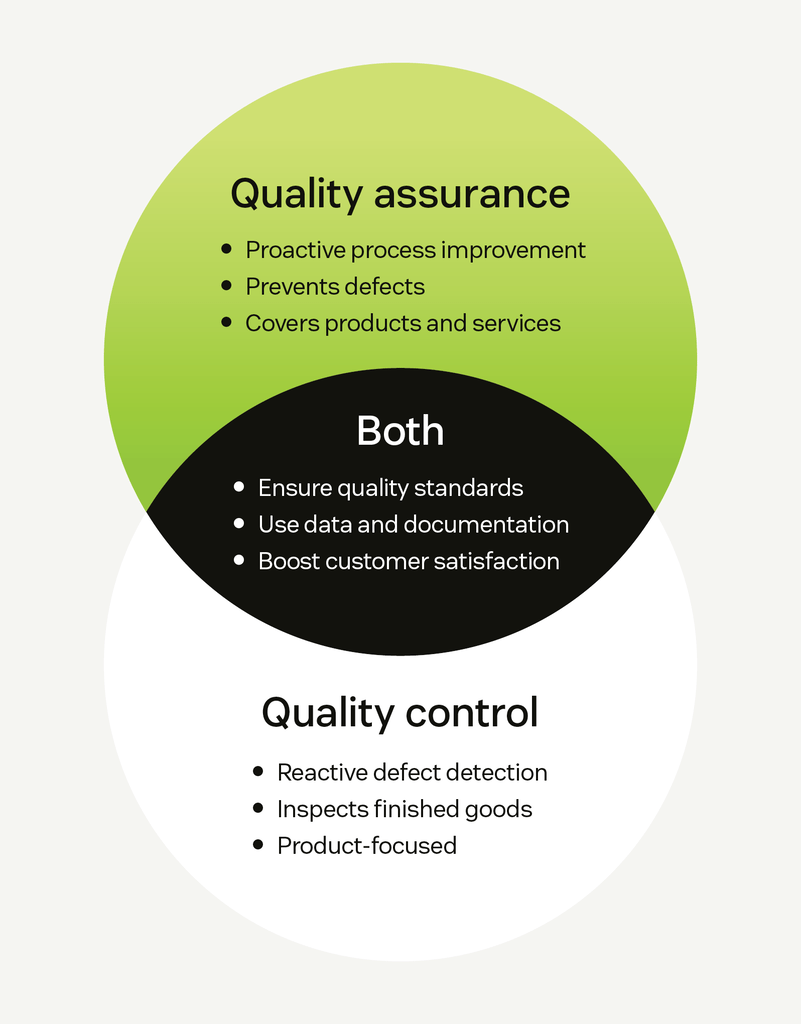Article • 6 min read
What is quality assurance (QA)? A complete guide
Quality assurance can reduce customer churn, help improve team performance, and cut operational costs. Increase confidence in your QA process with our guide.
Kevin Boyer
Sr Director, Product Marketing
Última atualização em October 6, 2025
Quality assurance definition
p>Quality assurance (QA) is a systematic approach designed to ensure that products and services consistently meet customer expectations, achieve service targets, and adhere to industry standards.
QA in customer service involves reviewing all support interactions, whether a customer is talking to a customer service agent or an AI agent. This provides critical insights into how to improve the performance of your support team, helping build customer loyalty and, ultimately, drive revenue.
Perception doesn’t always reflect reality. A patient might leave an appointment feeling reassured when, in reality, the doctor missed a critical diagnosis. The same thing can happen in customer service: Customers may provide positive feedback even if agents missed important steps or didn’t follow internal guidelines. That’s why quality assurance (QA) is so important—to uncover what feedback alone can’t reveal.
QA helps teams understand performance compared to all standards, processes, and protocols. Ensuring consistent service quality can improve customer loyaltyand brand trust. Use our guide to understand the importance of quality assurance and build exceptional QA processes today.
More in this guide:
- What is the difference between quality assurance and quality control?
- Why is quality assurance important?
- Common quality assurance methods
- How to perform quality assurance
- The role of QA by industry
- QA best practices
- Quality assurance examples
- Frequently asked questions
- Improve your customer service QA process with Zendesk
What is the difference between quality assurance and quality control?
People often mix up QA and quality control (QC), even though they describe distinct processes.
Quality control specifically targets physical products or service outputs, concentrating on adherence to quality requirements through operational techniques and methods.
In contrast, quality assurance is a more encompassing term that applies to both products and services and focuses on the overall processes to meet customer expectations. QA monitors interactions across channels in customer service to improve performance and customer satisfaction.

Common quality assurance methods
Quality assurance encompasses a variety of methods to evaluate performance and improve quality across customer interactions and operational workflows.
Here are a few common QA methods:
- Conversation reviews: Managers, QA specialists, or automated tools evaluate customer interactions (calls, chats, emails) to monitor quality and provide coaching.
- Specialist or QA team reviews: QA professionals evaluate interactions, processes, and performance trends holistically to identify gaps and recommend improvements. This includes Reviewer QA, which ensures consistency and accuracy among evaluators.
- AI-powered QA: AI tools analyze interactions at scale, flagging high-risk cases and surfacing trends faster than manual reviews.
- Manual QA: Human reviewers conduct detailed evaluations of individual interactions to provide personalized feedback and coaching.
- Voice QA: Teams monitor and assess voice-based customer interactions to ensure compliance and quality standards.
- AI agent QA: Specialists review and improve the quality of AI-driven customer service responses.+
Each method serves a specific purpose, from supporting daily coaching to driving broader process improvements. Most teams combine several approaches to fit their goals and team structure.
How to perform quality assurance
Effective quality assurance requires a well-defined structure and strategy. Here are some key steps to perform QA effectively:
- Define your quality standards: Set measurable criteria that reflect your brand and regulatory requirements.
- Plan your QA process: Decide who will conduct reviews, how often, and what tools or QA scorecards you’ll use to evaluate performance.
- Train your team: Ensure everyone understands the QA standards and receives ongoing training to stay aligned.
- Use AI as your first line of defense: Leverage AI-powered tools to automatically detect the most critical interactions that need human review.
- Automatically assign tickets for human review: Use AI to route flagged interactions to the appropriate reviewers, ensuring timely attention.
- Monitor performance and provide coaching: Use quality monitoringto track agent performance and identify coaching opportunities.
- Calibrate regularly and perform Reviewer QA: Align reviewer standards and evaluate the reviewers to maintain consistency.
It’s important to note that QA works best when treated as an ongoing cycle. A consistent, evolving QA process helps you catch issues early and strengthen team performance. Over time, this leads to more reliable service and stronger customer relationships.
The role of QA by industry
Almost every industry can improve the customer experience through quality assurance. Some industries depend on technical QA to set and uphold standards for developing or manufacturing reliable products, while others rely on QA to maintain service consistency and meet customer expectations.
These industries listed below could suffer massive losses without accurate QA processes:
- Manufacturing: QA ensures clear communication around product support and warranties, helping resolve customer issues promptly and improving overall satisfaction.
- Finance: Delivering secure and compliant customer interactions across voice, chat, and AI channels builds trust and meets regulatory requirements.
- Healthcare: Monitoring conversations helps staff provide accurate, empathetic support while maintaining patient confidentiality and compliance.
- Gaming:Ongoing quality assessments enable personalized service that addresses player concerns and strengthens engagement.
- Retail: Consistent service quality across touchpoints and locations creates seamless customer journeys that encourage repeat business.
Recognizing the specific demands and risks in your industry allows you to tailor QA processes that not only catch errors but also drive meaningful improvements in compliance and customer satisfaction.
QA best practices
Whether your QA standards are simple or complex, there are certain best practices all organizations should follow to ensure consistent quality across products and services.
To set up your QA process effectively, start with these steps:
- Create a dedicated QA team. Bringing together a group of subject matter experts can streamline processes and provide a point of contact for other team members seeking answers to questions.
- Define processes clearly. Document processes and quality standards and distribute records across an organization to ensure consistency.
- Set quality objectives and standards. Agree on measurable standards and objectives that tie directly to organizational goals.
- Adhere to customer expectations when setting standards. Consider customer insights when setting quality standards to improve customer satisfaction and loyalty.=
Once established, ongoing best practices for QA include:
- Invest in ongoing training and development. Regularly train team members on new or updated standards to guarantee quality.
- Prioritize transparent communication. Support organizational goals by informing teams of changes, expectations, and quality standards.
- Develop personalized interactions based on customer feedback. Collect and analyze feedback and use data about customer needs and expectations to inform quality standards.
- Conduct compliance and process audits. Assess compliance, identify improvement opportunities, and invest in internal growth.
- Analyze and understand team performance. Quickly identify knowledge gaps on the team, tier, and agent levels.
- Leverage AI to streamline the QA process. Automate QA processes to cover every support interaction and ensure no areas for improvement are overlooked.
- Collaborate with team members. Encourage internal collaboration to help all team members claim responsibility for quality and service standards.
- Regularly review and improve processes. Consistently review current processes to identify areas for holistic improvement.
Quality assurance examples
Not all quality assurance processes are identical, but organizations benefit from individualized practices. By investing in customer service quality assurance, these businesses have significantly improved service quality and standardization.

CityGo
As CityGo scales its carpooling service across multiple time zones, Zendesk QA helps its customer service team maintain high standards and consistency. Using AI tools like the Outlier filter, the team quickly identifies important interactions to review and proactively resolves issues before they escalate.
CityGo prioritizes internal quality scores over traditional metrics to ensure agents consistently meet company standards, even amid regulatory complexities and rapid growth. This data-driven approach to QA supports frontline teams while influencing broader product and marketing decisions, helping deliver a seamless customer experience.
Liberty
Similar to Found, the renowned luxury department store, Liberty, found that prioritizing customer service QA enhanced their holistic customer service experience. With Zendesk QA, their teams systematized the QA review process, allowing reviewers to regularly assess how Liberty agents adopted and used the brand’s tone and voice.
Liberty reviewers also standardized all feedback to flow through one system, reinforcing the need for consistency and regularity throughout all stages of service and review. The team at Liberty now conducts monthly calibration sessions to ensure QA is properly conducted and recorded.
Buffer
Buffer streamlined its customer advocacy QA process by switching from spreadsheets to Zendesk QA, cutting review time by 50 percent. ItsTheir fully remote customer advocacy team uses Zendesk to quickly identify the most impactful conversations, making reviews more efficient without sacrificing quality.
This approach allows Buffer to focus on continuous improvement rather than perfection, freeing managers from administrative tasks to invest more in coaching and team development. Zendesk QA helps Buffer sustain quality service as its product evolves and customer expectations rise.
Frequently asked questions
Improve your customer service QA process with Zendesk
QA is the foundation for building lasting customer trust and operational excellence. However, scaling these efforts without losing precision or overwhelming your team is challenging.
Zendesk QA uses advanced AI to automate routine reviews and identify critical issues, enabling your team to focus on coaching and strategic improvements. With no coding or AI training required, you can hit the ground running and start elevating your quality assurance process on day one.
